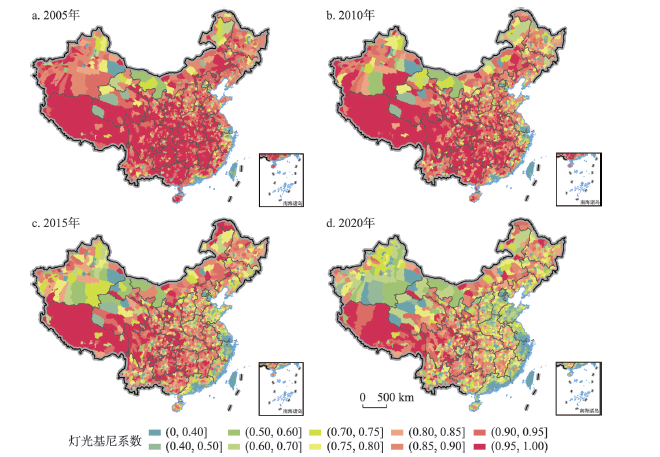

Dynamics of developmental vitality and equilibria of counties in China based on nighttime lights data
Received date: 2022-02-26
Revised date: 2022-10-28
Online published: 2023-04-14
Supported by
National Natural Science Foundation of China(71774151)
National Natural Science Foundation of China(42171208)
Eliminating inequality and achieving balanced development is one of the Sustainable Development Goals of the United Nations. Accurate measurement of development equilibrium is a primary scientific problem to be solved urgently. Nighttime lights data have been proven to be a good proxy for economic activity, and they have been used widely due to their advantages of convenient acquisition and wide spatial coverage. Therefore, in this study, we applied the Gini coefficients derived from nighttime lights data and pixelized population data to evaluate the development equilibria for China's 2900 counties from 2002-2020. We then examined the nexus of the development equilibrium and developmental vitality represented by the average nighttime lights intensity within each county. The results showed that the Gini coefficients based on nighttime lights data have generally been decreasing for 96% of the counties in China during 2002-2020. Moreover, in general, the Gini coefficients present a spatial pattern of being lower in the east and higher in the west. The results illustrate the synergetic development pathways of economic growth and equilibrium promotion of the economically developed counties, although the variation of their equilibria is significant. On the contrary, there is still distinct room for improvement of development equilibria for 60% of the economically underdeveloped counties in China. The results provide scientific support for achieving balanced development and promoting common prosperity in China.

LIU Lingcen , SUN Zhongxiao , WU Feng , LI Yuheng , ZHANG Qian . Dynamics of developmental vitality and equilibria of counties in China based on nighttime lights data[J]. Acta Geographica Sinica, 2023 , 78(4) : 811 -823 . DOI: 10.11821/dlxb202304003
| [1] |
|
| [2] |
|
| [3] |
[邓祥征, 梁立, 吴锋, 等. 发展地理学视角下中国区域均衡发展. 地理学报, 2021, 76(2): 261-276.]
|
| [4] |
United Nations. SDG Indicators. https://unstats.un.org/sdgs/report/2020/goal-10.
|
| [5] |
Central People's Government of the People's Republic of China. Outline of the 14th Five-Year Plan (2021-2025) for National Economic and Social Development and Vision 2035 of the People's Republic of China. http://www.gov.cn/xinwen/2021-03/13/content_5592681.htm.
[中华人民共和国中央人民政府. 中华人民共和国国民经济和社会发展第十四个五年规划和2035年远景目标纲要. http://www.gov.cn/xinwen/2021-03/13/content_5592681.htm.]
|
| [6] |
The State Council of China. Strategic Planning for Rural Revitalization (2018-2022). Beijing: People's Publishing House, 2018: 21-23.
[中共中央国务院. 乡村振兴战略规划(2018—2022). 北京: 人民出版社, 2018: 21-23.]
|
| [7] |
[刘慧. 区域差异测度方法与评价. 地理研究, 2006, 25(4): 710-718.]
|
| [8] |
|
| [9] |
|
| [10] |
|
| [11] |
[陈颖彪, 郑子豪, 吴志峰, 等. 夜间灯光遥感数据应用综述和展望. 地理科学进展, 2019, 38(2): 205-223.]
|
| [12] |
[徐康宁, 陈丰龙, 刘修岩. 中国经济增长的真实性: 基于全球夜间灯光数据的检验. 经济研究, 2015, 50(9): 17-29, 57.]
|
| [13] |
|
| [14] |
|
| [15] |
|
| [16] |
[余柏蒗, 王丛笑, 宫文康, 等. 夜间灯光遥感与城市问题研究: 数据、方法、应用和展望. 遥感学报, 2021, 25(1): 342-364.]
|
| [17] |
|
| [18] |
|
| [19] |
|
| [20] |
|
| [21] |
|
| [22] |
|
| [23] |
|
| [24] |
|
| [25] |
|
| [26] |
|
| [27] |
[彭博, 张倩, 刘立程, 等. 夜间灯光视角下的新疆发展均衡性动态研究. 测绘科学, 2022, 47(1): 133-141.]
|
| [28] |
[黄祖宏, 王新贤, 张玮. 青藏高原地区人类发展水平评估及其演变分析. 地理科学, 2021, 41(6): 1088-1095.]
|
| [29] |
|
| [30] |
|
| [31] |
[刘彦随. 中国新时代城乡融合与乡村振兴. 地理学报, 2018, 73(4): 637-650.]
|
| [32] |
Xinhua News Agency. The General Offices of the CPC Central Committee and The State Council issued the Opinions on Promoting Urbanization Construction with County Towns as Important Carriers. http://www.gov.cn/zhengce/2022-05/06/content_5688895.htm.
[新华社. 中共中央办公厅、国务院办公厅印发《关于推进以县城为重要载体的城镇化建设的意见》. http://www.gov.cn/zhengce/2022-05/06/content_5688895.htm.]
|
| [33] |
[曹子阳, 吴志峰, 匡耀求, 等. DMSP/OLS夜间灯光影像中国区域的校正及应用. 地球信息科学学报, 2015, 17(9): 1092-1102.]
|
| [34] |
|
| [35] |
[柏中强, 王卷乐, 杨飞. 人口数据空间化研究综述. 地理科学进展, 2013, 32(11): 1692-1702.]
|
| [36] |
|
| [37] |
[樊杰, 王亚飞, 梁博. 中国区域发展格局演变过程与调控. 地理学报, 2019, 74(12): 2437-2454.]
|
| [38] |
[齐元静, 杨宇, 金凤君. 中国经济发展阶段及其时空格局演变特征. 地理学报, 2013, 68(4): 517-531.]
|
| [39] |
[樊杰, 赵浩, 郭锐. 我国区域发展差距变化的新趋势与应对策略. 经济地理, 2022, 42(1): 1-11.]
|
| [40] |
[孟斌, 王劲峰, 张文忠, 等. 基于空间分析方法的中国区域差异研究. 地理科学, 2005, 25(4): 393-400.]
|
/
| 〈 |
|
〉 |